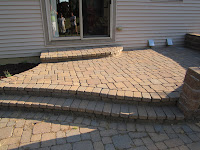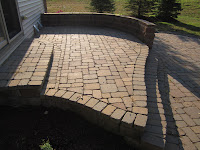I am very select in the
brick paver installation projects that I will perform in a given year. I will not bid on every
brick paver patio, walkway, driveway lead that I am contacted on. I am not interested in bidding against inferior
brick paver installers like landscapers who cut corners, create poor designs, and do not pay attention to custom detail. Customers who seek brick paver excellence and education are the clients I seek to service.
This
paver patio project was beneficial to both the homeowner and myself because we were on the same page throughout this
paver patio project. I feel this is the best method of
installing a brick pavers project that insures a successful business arrangement between client & contractor.
This client had an open schedule, had researched the product and new what they wanted, and had budgeted from installations we had performed for family & friends. After I made some crucial recommendation to the
paver patio size and layout, the
brick paver installation commenced. We used
UNILOCK's Stonehenge 3 shape brick pavers and Roman Pisa wall & caps to construct the
raised patio frame & step.
Here is the
"Anatomy of a Raised Brick Paver Patio" that we installed for this client. Performing basic
brick paver and modular retaining wall techniques will insure the long-term success and beauty of this
raised paver patio. Enjoy this picture time line and I hope it helps educate homeowners and
brick paver contractors a like.

The customer had a patio stone patio laid on an inch or two of sand. This was a temporary patio until they could reach their budget for the "real"
paver patio they desired! As you can see, the patio size did not facilitate the patio furniture and grill. We began by removing the
patio stones, temporary cinder block steps, and removed the sod where the new raised patio was to be installed. We removed 10-12" more of the sod on the outside of the expected
paver patio.


We started by shooting heights for the
paver patio by using one of the most important tools for any
brick paver contractor..the transit level. We then dug our trench for the
modular retaining wall blocks. These
Unilock blocks are 12" deep so we dug the trench 20" wide (4" either way) and dug deep enough to install 6" of compacted gravel under the blocks. The
retaining wall block trench then was filled and compacted with 1" down to fines crushed gravel.


The compacted gravel was then screeded and set to the height needed to set the
modular retaining wall blocks & caps to the finished height of the
paving stones of the patio. The radius and gapping of the blocks were set to best fit the limitations of the product and the objectives of the
paver patio design. It is best to merge the restrictions of the products and objectives of the design to best maximize the appearance of the final product.

Filter fabric (geo-textile blanket) is installed under
paver base material and behind wall blocks to limit filtration of sub soil into
paver base and limit any washout through joints of wall blocks.
The gaps of the wall blocks are filled and compacted prior to capping. This also will help firm up the wall and give it some added strength and help from settling behind the wall.
Wall caps were marked for diamond blade cuts and done uniformally to give the wall a finished look with no gaps.
This is a tedious task having to cut each cap in the radius but the finished look sets off the whole appearance of the
paver patio giving it that rich coping look with a natural rock face.
Cutting with Diamond Blade saws is usually best done by a
brick paver contractor. Many inexperienced paving contractors or homeowners use a guillotine cutter (hydraulic snap) or just plain out leave gaps for a poor finish look.

Once the
modular retaining wall blocks & caps were installed for this raised paver patio, the entire area was filled with paver base material in 4-5" lifts. Each lift was raked level and compacted with a
power plate compactor. Tight areas along the back of the wall blocks and house were completed by a hand tamper. This particular
raised paver patio needed @ 8" (2 Lifts) of compacted paver base to allow for the
bedding course &
paving stone thickness.
It is important to make sure the
paver base is compacted level. If compacted uneven or pitching back to the house, the results over the years will be a wavy and improper pitching paver surface. The top of the paver patio will mimics the base below over time. The
compacted paver base is your foundation!
After the
paver base material is correctly leveled and compacted, it is time to bring in the
bedding course. The bedding course is the 1 to1 1/2" layer of screed that will be the layer of base for the
interlocking pavers to
"lock up" into. It is also the leveling course for the finished
paving stone height. In Michigan, we use either 2NS Sand (similar to sharp sand) or 30A Slag Sand.
Here is where the real magic occurs for the
experienced brick paver contractor....leveling the
bedding course to prepare for the proper installation of the
paving stones. The heights and pitches need to be correct to insure a well draining patio and appearance. Screed poles, level transit, and patience are most during this stage. Done correctly, the laying of the
paving stones will be simple and timely.
Due to the size of this
paver patio, we decided to split the
brick patio in half and screed one area, lay the
paving stones, then screed the second half and finish laying the remaining
paving stones. Screed poles which are no more than galvanized 10ft poles bought at a hardware store are suffice. We usually use 3 poles at a time to screed large areas. The poles are reset and checked for height & pitch a few times before the final screeding takes place. After the final screed, the poles are carefully removed and the holes left are filled.
For areas that are tight or irregular, a keen eye and experienced "hand" screed is done with a mason's spatula. Going in different directions so slightly will help insure holes or voids being filled. We will check these areas with small torpedo levels to insure proper pitch.
After we were satisfied that the screed was prepared for the laying of the
paving stones, we began laying the interlocking brick pavers. We discussed the best place to start the pattern to insure the best look of the
paver patio. We take in effect all sides of the patio and where best cuts should be performed. Most inexperienced
brick paver contractors just start laying and worry about the outcome at the end. This can lead to a cut up or botched finish look. Much like inside tile work, there is a thought process that needs to take place.
String lines are used periodically to insure that the laying pattern of the
brick pavers is not "floating" or "veering off". It is amazing how dimensional paving stones will be off due to variances in the dimensions of the
paving stones themselves. If your
brick paver installer is using string lines to
level your pavers, you are in trouble! String lines or more accurate in squaring off patterns or aligning borders.
Mixing from multiple
paving stone bundles is a must to insure a good color mix. Not all bundles of pavers or wall blocks are mixed evenly in color due to production lots. If you do not mix, even within a bundle itself, your final paver patio may have an uneven quilt look of dark and light stones. We always inspect the paver bundles prior to laying and discuss the strategy for grabbing the pavers & spotting. It is best to mix the color shades while spotting so the
brick paver layer can move quickly and not fuss with changing out
paving stones.
After all the
paving stones were laid in full pieces throughout this
raised paver patio, the piecing of all openings takes place. We cut all of our
paving stones with a diamond blade and use both a chop saw and cut saw (fireman's saw). It is important to set the brick paver cut in the opening and mark for cutting. Cutting is an art for some. Some workers are a wizz and others struggle. That is what makes someone a carpenter and another a mechanic. When ordering your product for a paver project, you should add upto 10% more to account for the loss of cuts that are not going to be usable.
We now give the entire
brick paver patio an initial sweep of
regular paver joint sand or polymeric sand. Do not worry about filling every little joint as you will be doing a finish sweeping later. Make sure that the
brick patio or
paver joint sand is completely dry when sweeping.
We then use the
power plate compactor to set the
interlocking pavers into the
bedding course to achieve lateral "lock up" and set in our
paver joint sand. We went in several directions to insure proper lock up and followed up with the hand tamper in tight spaces where the
plate compactor could not get into. After we are satisfied with the final compaction of pavers, we do the finish sweep with the
paver joint sand, making sure we get all joints and nooks & crannies.
 Here is the finished patio!
Here is the finished patio! Another estactic and satisfied client by
Brick Doctor Bill. It was a pleasure working with a client who allowed us to work with the products benefits and now they will enjoy a patio for life. With proper yearly minor maintenance like sand sweeping and addressing any substantial settling due to frost damage, this raised
paver patio will give years of enjoyment and neighbor envy.
At the end of the job, I spent about 45 minutes educating the client on the
paver maintenance requirements, options of
polymeric sand or sealing, what to look out for to avoid future costly
brick paver repairs, and how best to rub it in our your neighbor...lol.
I will return in the future to post great pics of the
paver patio maturing and landscaping accents. I hope this pictorial was helpful in assuring a successful and long-term brick
paver patio investment for you. On to our next "house call" we go!
 Brick Doctor Bill and crew installed this simple & beautiful Raised Pavers Patio in Scio Township, MI this past month. We removed old wooden decks for 2 other family members of this homeowner and replaced their decks with functional, low maintenance, and creative raised brick paver patios.
Brick Doctor Bill and crew installed this simple & beautiful Raised Pavers Patio in Scio Township, MI this past month. We removed old wooden decks for 2 other family members of this homeowner and replaced their decks with functional, low maintenance, and creative raised brick paver patios. This homeowner did not currently have any outdoor living space structures and wanted us to build them a spectacular patio that they will enjoy for many years to come. Entertainment space and traffic flow were key factors in the homeowner's needs for a paver patio.
This homeowner did not currently have any outdoor living space structures and wanted us to build them a spectacular patio that they will enjoy for many years to come. Entertainment space and traffic flow were key factors in the homeowner's needs for a paver patio.




































































